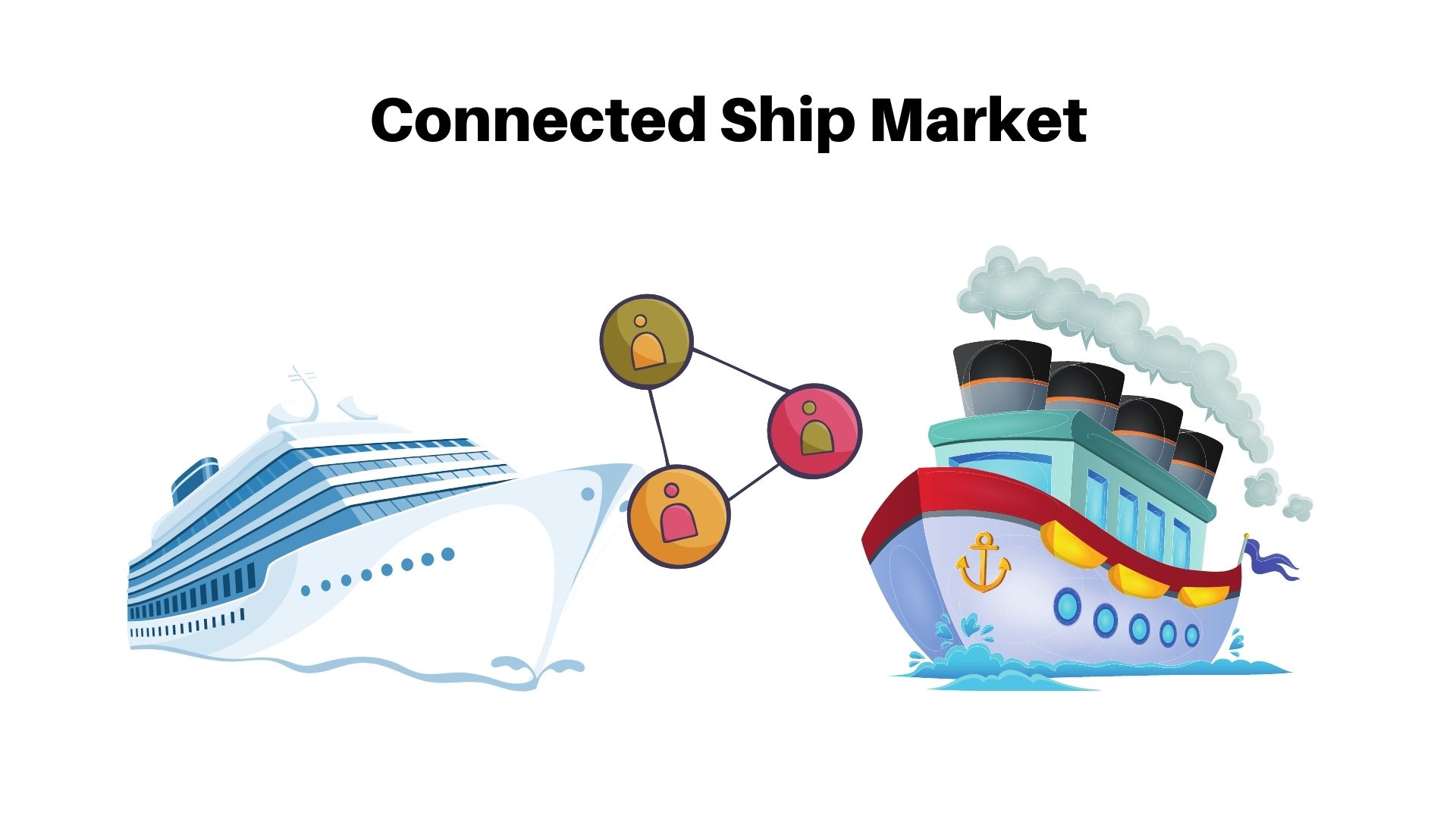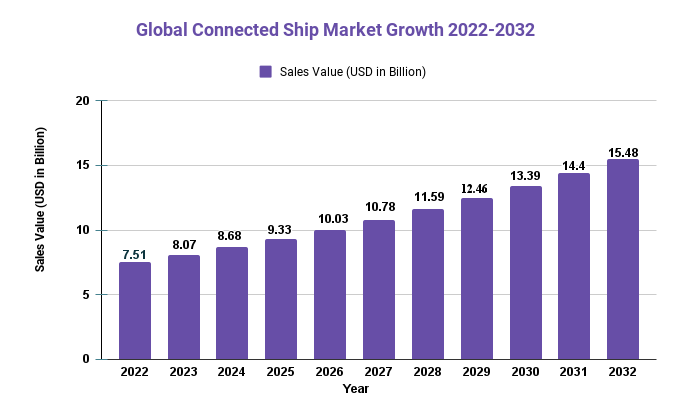Connected Ship Market Size Will Reach USD 15.48 billion by 2032

Page Contents
Market Overview
Published Via 11Press: Market.us predicts the global connected ship market to experience rapid growth over the coming years, with a compound annual growth rate (CAGR) of 7.5% from 2022-2032. Valued at USD 7.51 billion in 2022, this market is predicted to reach an impressive USD 15.48 billion by 2032.
The connected ship market is driven by several factors, including the increasing demand for digitalization and automation in shipping, tighter government regulations regarding maritime safety and security, as well as real-time monitoring and analytics to optimize ship operations.
Geographically, the connected ship market is divided into North America, Europe, Asia-Pacific, and other regions of the world. Asia-Pacific is expected to dominate this space over the coming years due to a large number of shipping companies there as well as government initiatives that encourage digital technology adoption within this sector.
Overall, the connected ship market offers tremendous growth potential and is expected to keep expanding over the coming years. Nonetheless, it is highly competitive with a multitude of companies competing for market share. Companies that develop innovative products or services and forge strong partnerships are likely to be successful in this competitive space.
Request For Sample Report Here: https://market.us/report/connected-ship-market/request-sample
Key Takeaway
- The connected ship market is expected to experience tremendous growth over the coming years, driven by increasing demands for digitalization and automation in shipping, tighter government regulations regarding maritime safety and security, as well as real-time monitoring and analytics of ship operations.
- The hardware segment, consisting of sensors, antennae, and other components, is expected to dominate the market in 2018. Meanwhile, services such as consulting, installation, and maintenance services will witness a higher compound annual growth rate due to increasing demand for managed services.
- The Asia-Pacific region is expected to dominate the market owing to a high concentration of shipping companies there and government initiatives designed to promote digital technologies within this sector.
- Overall, the market offers significant potential for growth; however, it is highly competitive. Companies that can develop innovative products and services and forge strong partnerships are likely to be successful in this environment.

Regional Snapshot
- North America is a key market for connected ships due to the abundance of shipping companies and ports there. The United States and Canada are expected to lead market growth within North America. The region is being driven by an increasing need for real-time monitoring, analytics, as well as improved safety measures within the shipping industry.
- Europe is a key market for connected ships due to the abundance of shipping companies and ports in the area. The region's growth is being driven by increasing demands for digitalization and automation within the shipping industry, as well as improved safety measures. Germany, France, and the United Kingdom are expected to be major contributors to market expansion throughout this region.
- The Asia-Pacific region is expected to lead the connected ship market due to a large number of shipping companies and government initiatives that promote digital technologies within this industry. China, Japan, and South Korea are predicted to be major contributors toward market expansion within this region.
- The rest of the world segment encompasses Latin America, the Middle East, and Africa. This market is driven by increasing demands for digitalization and automation within the shipping industry as well as improved safety measures. Brazil, United Arab Emirates, and South Africa are expected to be major contributors to growth within this segment.
Drivers
- Increased demand for digitization and automation within the shipping industry: The shipping industry is facing increasing challenges in terms of safety, efficiency, and sustainability. Connected Ships provide real-time monitoring, analytics, and automation capabilities which enable shipping companies to optimize their operations and cut costs.
- Increasing government regulations for maritime security and safety: Around the globe, governments are implementing regulations that will improve the safety and security both of the crew and the ships. Connected vessels provide advanced monitoring capabilities and communication capabilities. This helps improve the security and safety of the shipping industry.
- Need for real-time analysis and monitoring of ship operations. Connected ships offer real-time monitoring, analytics, and optimization capabilities for shipping companies. This allows shipping companies to improve their efficiency and profitability.
- Advancements in sensors technologies: IoT sensors as well as RFID tags have made a lot of data possible from ships. This data can also be used for analytics and monitoring in real-time, which improves the efficiency and safety of shipping operations.
- International trade has risen: Shipping services have seen an increase in demand. Connected vessels provide advanced capabilities which enable shipping companies to respond to the growing demand and lower costs.
Restraints
- High Implementation Costs: Adopting connected ship technologies can be expensive, which may deter some shipping companies from taking advantage of them.
- Lack of Standardized Regulations and Protocols: Currently, there are no standardized regulations or protocols for connected ships, creating confusion and complexity during implementation and interoperability.
- Cybersecurity Concerns: Ships connected to the internet can be vulnerable to cyber-attacks that could compromise their safety and security as well as that of their crew and cargo. This poses a problem for shipping companies, who may feel compelled to defer investing in these technologies due to these potential threats.
- Lack of Skilled Personnel: Connected ship technologies require highly qualified personnel to implement and operate. A shortage of these personnel can pose obstacles during implementation and adoption.
- Limited internet connectivity in some regions: The effectiveness of connected ship technologies relies on reliable internet connection. Unfortunately, internet availability can be patchy in certain places, which may hinder their adoption.
Opportunities
- High implementation costs: Adopting connected ship technologies can be expensive, which may deter some shipping companies.
- Inadequacy of standard regulations and protocols: Unfortunately, there are currently no standardized regulations or protocols for connected ships. This leads to confusion and complex implementation processes.
- Cybersecurity Risks: Ships connected to the internet may be susceptible to cyber-attacks. This poses a risk to their safety and security, as well as that of crew and cargo on board. This has caused concern among shipping companies who may have been discouraged from utilizing these technologies due to potential security risks.
- Lack of Skilled person: Skilled personnel is necessary to operate and implement connected ship technologies. Without sufficient expertise, implementation and adoption may prove challenging.
- Reliable internet connectivity is essential for the successful deployment of connected ship technologies. Unfortunately, some regions lack adequate internet service coverage, potentially impeding adoption and utilization of these advanced tools.
View Detailed TOC of the Report | https://market.us/report/connected-ship-market/table-of-content/
Challenges
- Cybersecurity: Ships have become more interconnected, leaving them more vulnerable to cyber attacks that could endanger crew and cargo as well as disrupt operations on board. To reduce these risks, the industry needs to develop robust cybersecurity protocols and invest in advanced security technologies.
- Data Privacy: The collection and storage of sensitive data, such as crew members' personal information, raises privacy concerns. To safeguard crew members' rights to privacy and prevent misuse, the industry needs to establish clear policies for data collection, storage, and sharing that adhere to international standards.
- Regulatory Compliant: The connected ship market must adhere to various regulations, such as those regarding safety, emissions and cybersecurity. The industry must guarantee it abides by all pertinent rules and standards which may differ by region and country.
- Infrastructure and Connectivity: The efficiency of connected ships relies on reliable, fast connectivity – something which may be challenging in remote or congested regions. To guarantee seamless connectivity across all regions, the industry needs to invest in advanced communication technologies and infrastructure.
- Cost Effectiveness: Although the advantages of connected ships are many, the initial costs to install and maintain advanced technologies can be substantial. Therefore, efforts should be made to reduce expenses and make these technologies more accessible to all types of vessels.
Market Segmentation
Ship Type
- Defense
- Commercial
Installation Type
- Onshore
- Onboard
Application
- Vessel traffic management
- Fleet health operations
- Fleet operations
Market Players
- General Electric
- Emerson Electric Co. Company Profile
- Wartsila Corp.
- Kongsberg Gruppen
- Schneider Electric SE. Company Profile
- ABB Ltd Company Profile
- Valmet Oyj
- RH Marine
- Other Key Players
Report Scope
| Report Attribute | Details |
| The market size value in 2022 | USD 7.51 Bn |
| Revenue forecast by 2032 | USD 15.48 Bn |
| Growth Rate | CAGR Of 7.5% |
| Regions Covered | North America, Europe, Asia Pacific, Latin America, and Middle East & Africa, and Rest of the World |
| Historical Years | 2017-2022 |
| Base Year | 2022 |
| Estimated Year | 2023 |
| Short-Term Projection Year | 2028 |
| Long-Term Projected Year | 2032 |
Frequently Asked Question
Q: What is the current market size for the connected ship?
A: According to a report by Market.us, the connected ship was valued at USD 7.51 billion in 2022 and is expected to reach USD 15.48 billion by 2032, growing at a CAGR of 7.5% during the forecast period.
Q: What are the key segments of the connected ship?
A: The connected ship can be segmented based on By Ship Type (Defense, Commercial), By Installation Type (Onshore, Onboard), And by Application (Vessel traffic management, Fleet health operations, Fleet operations)and geography (North America, Europe, Asia-Pacific, Latin America, and Middle East & Africa).
Q: Who are the key players in the connected ship?
A: Some of the key players in the connected ship include General Electric, Emerson Electric Co. Company Profile, Wartsila Corp., Kongsberg Gruppen, and Schneider Electric SE. Company Profile, ABB Ltd Company Profile, Valmet Oyj, RH Marine, Other Key Players.
The team behind market.us, marketresearch.biz, market.biz and more. Our purpose is to keep our customers ahead of the game with regard to the markets. They may fluctuate up or down, but we will help you to stay ahead of the curve in these market fluctuations. Our consistent growth and ability to deliver in-depth analyses and market insight has engaged genuine market players. They have faith in us to offer the data and information they require to make balanced and decisive marketing decisions.